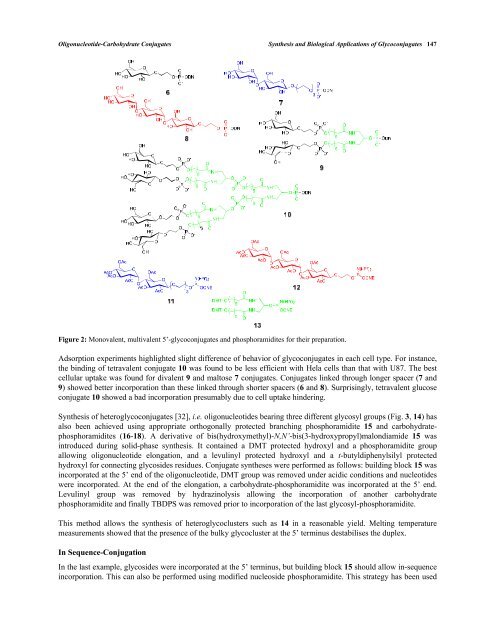chapter 2 - Bentham Science
chapter 2 - Bentham Science
chapter 2 - Bentham Science
You also want an ePaper? Increase the reach of your titles
YUMPU automatically turns print PDFs into web optimized ePapers that Google loves.
Oligonucleotide-Carbohydrate Conjugates Synthesis and Biological Applications of Glycoconjugates 147<br />
Figure 2: Monovalent, multivalent 5’-glycoconjugates and phosphoramidites for their preparation.<br />
Adsorption experiments highlighted slight difference of behavior of glycoconjugates in each cell type. For instance,<br />
the binding of tetravalent conjugate 10 was found to be less efficient with Hela cells than that with U87. The best<br />
cellular uptake was found for divalent 9 and maltose 7 conjugates. Conjugates linked through longer spacer (7 and<br />
9) showed better incorporation than these linked through shorter spacers (6 and 8). Surprisingly, tetravalent glucose<br />
conjugate 10 showed a bad incorporation presumably due to cell uptake hindering.<br />
Synthesis of heteroglycoconjugates [32], i.e. oligonucleotides bearing three different glycosyl groups (Fig. 3, 14) has<br />
also been achieved using appropriate orthogonally protected branching phosphoramidite 15 and carbohydratephosphoramidites<br />
(16-18). A derivative of bis(hydroxymethyl)-N,N’-bis(3-hydroxypropyl)malondiamide 15 was<br />
introduced during solid-phase synthesis. It contained a DMT protected hydroxyl and a phosphoramidite group<br />
allowing oligonucleotide elongation, and a levulinyl protected hydroxyl and a t-butyldiphenylsilyl protected<br />
hydroxyl for connecting glycosides residues. Conjugate syntheses were performed as follows: building block 15 was<br />
incorporated at the 5’ end of the oligonucleotide, DMT group was removed under acidic conditions and nucleotides<br />
were incorporated. At the end of the elongation, a carbohydrate-phosphoramidite was incorporated at the 5’ end.<br />
Levulinyl group was removed by hydrazinolysis allowing the incorporation of another carbohydrate<br />
phosphoramidite and finally TBDPS was removed prior to incorporation of the last glycosyl-phosphoramidite.<br />
This method allows the synthesis of heteroglycoclusters such as 14 in a reasonable yield. Melting temperature<br />
measurements showed that the presence of the bulky glycocluster at the 5’ terminus destabilises the duplex.<br />
In Sequence-Conjugation<br />
In the last example, glycosides were incorporated at the 5’ terminus, but building block 15 should allow in-sequence<br />
incorporation. This can also be performed using modified nucleoside phosphoramidite. This strategy has been used

















